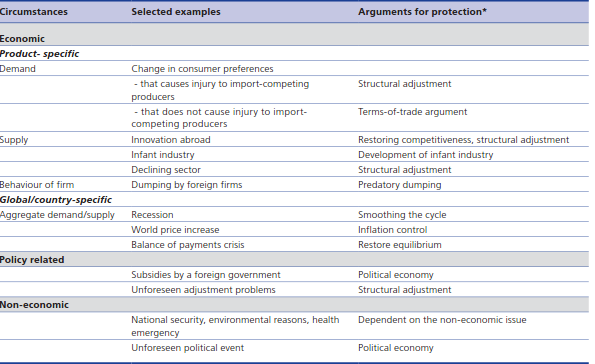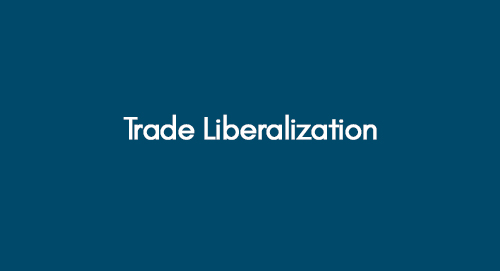
Exploring Alternative Asset Classes in Consultancy Project
December 20, 2020
Analyzing Factors Responsible for Leadership Gap in Healthcare System: Suggesting Viable Solutions
December 21, 2020Trade liberalization is a policy or practice that promotes the reduction or elimination of restrictions on international trade, such as tariffs and import quotas. It aims to foster greater economic openness and enhance global commerce. Trade liberalization refers to reducing or removing barriers that may hinder the free movement of goods across territories.
Introduction
This integration into the economy through international trade has not only strengthened the global economy but has also substantially reduced poverty and enhanced development at the domestic level. It has been observed that over the last two decades, there has been an increase of six percent in global trade, which is invariably twice as much as the global output. The General Agreement on Tariffs and Trade, GATT, was created in 1947 and resulted in eight subsequent rounds of multilateral, regional and unilateral trade liberalization, after which the World Trade Organization was established (Heerat, 2010). The progress of integration throughout the globe has not been consistent; for example, within Asia, the progression through trade liberalization has been immense since they participated in the strategies for attracting foreign direct investment, but the same has been comparatively lower in Latin America.
The progress experienced through trade liberalization has been particularly slow in the Middle East and African regions. This is particularly because these regions did not lower their trade barriers in an era of world economic integration and thereby suffered at the hands of international trade, thereby putting them at the risk of marginalisation (Mkubwa, 2014). These regions, along with other developing and underdeveloped countries, are disproportionately dependent upon the export and production of traditional commodities. Protection of the homeland, weak policy frameworks, weak institutions and structural problems all lead to marginalisation by the countries with regard to international trade and global development (Pachecko, 2011).
The Rationale behind Imposing Trade Restrictions
Governments usually involved in protectionism may revert back to various trades-related negotiations where they face unforeseeable circumstances that make the previous statements inefficient (Mayer et al., 2014).
Learn More UK and Its Trading Partners
Where the market is observed to fail, the governments can agree to increase the barriers to trade which will be deemed the second-best policy for the economic development of the particular country (Salinaz and Aksoy, 2011). The following figure illustrates the various reasons countries may impose from the economic theory perspective.

Figure 1 Reasons for the increase in Trade barriers.
Product Specific
There are some unexpected circumstances related to trade, such as technological interventions, changes in customer behaviour or market procedures.
Changes in Customer Preferences
Change in customer preferences occurs when the customer demand increases or decreases for a particular product. In this case, one can be benefited while the other industry or the partner has to suffer, but the temporary losses can be recovered.
Technological Innovation
This could be the case. For instance, if one party advances its technological procedures by replacing the labour force, the other partner with outdated technology is in danger of suffering from a loss. There are some tactics that can help prevent the great extent of loss (Ikenson, 2007). Tariffs, trade barriers and increases in the price of the product are some ways to tackle this kind of situation. The suffering ones should respond to the losses in case they are temporary in such a way that they should carry on with their production because the losses would recover if they are temporary (Feenstra et al., 2014). Moreover, if they totally abandon themselves and stay out of the loop, then there is a danger of them getting outside the business loop. So, there must be a constant urge to struggle by the suffering party in order to boost up their image in the trading sector.
Infant Industry
An infant industry is a newly formed local industry in its initial phases of practice. Such industries find it very difficult to compete with other overseas industries on the international platform markets. Over the years, these industries will learn how to attract business by controlling their costs, but in the beginning, the industry might not be able to experience success due to the trade barriers. If there is little or no risk involved in financing a business endeavour, then the financial markets will be willing to do so, but if there is risk involved, then it is important that government increases trade barriers so that local industries can finance themselves on their own. When talking about infant industry policy, it is important to understand that subsidy and externalities play a crucial role. Money is invested in job training of new employees, and if these employees share their knowledge or shift to other firms, then this is counted among the externalities. There is always uncertainty involved in selling local goods abroad, and therefore export subsidy might prove beneficial in this case. Once these policies are formed, it is the responsibility of the government to implement them.
Declining Industry
A declining industry is when that industry’s production begins to decline, leading to the shutting down of the business. The sudden decrease in production can be attributed to declining in demand, lack of resources or to advancements in technology. Whenever this happens, trade restrictions are recommended to provide enough time for the employees to find other jobs. Large-scale declining industries can have a negative impact on the surrounding area; therefore, it is important that the government gets involved in slowing down the decline.
Dumping
When a foreign firm lowers the price of a particular good in the international market, it means that it wants to dominate the market and eliminate the competitors; therefore, in this case, the government should play its role in guarding domestic industries by introducing trade restrictions.
Global or Country-Specific Economic Fluctuations
Country-specific fluctuations impact all the sectors simultaneously, and changes in outlay can affect the demand and supply.
Economic Recession
A decline in local and foreign demand is observed when the recession is on a global scale. In this case, the government might have to introduce new trade barriers to reserve local markets for the local firms. Introducing such a protective measure might result in reprisal and unrest in the neighbouring countries. Eventually, these trade barriers will be applied by all the countries around the globe (Panangariya, 2000). The culmination of this situation would be depression resulting from a decrease in global wellbeing and bad economic conditions.
Changes in World Prices
When the price of domestic goods increases compared to the foreign goods, then the demand also shifts towards the imported goods side, and when the domestic goods are cheaper, preference shifts on their side. The overall increase in world prices would harm both as imported goods would cost more and domestic supply will reduce. Government can impose export restrictions to insulate and safeguard their domestic markets.
An Unsuitable Balance of Payments Situation
Balance of payments includes the payments made inside or outside the country. There are two impacts of lower currency, the first is that the price of local goods would decrease, and their demand in the foreign world would increase, and at the same time, it will increase the cost of foreign goods, and their demand within a specific country would decrease (Bhagwati, 2010). Secondly, if the local currency is not appreciated, then the rate of return on foreign assets also declines. To avoid such unbalanced conditions, it is essential to fix the rate of exchange.
Changes in Policy
Changes in government policies can have both negative and positive impacts on the economy. These are discussed below:
1. Trade Opening
On international platforms, firms that lack comparative advantage have to endure a lot of stress and burden from the severe competition. This can even result in the loss of jobs and shutting down of businesses. The governments, in this case, should provide more time for the firms to make certain adjustments (Hussain, 2007). The government can do this by two possible methods. The first is by reallocating the resources, and the second is by helping industries recover from the damages sustained by the severe competition.
Sometimes it happens so that the foreign country provides a subsidy over its export of certain goods to check the potential of its selling in the international market. In such a case, the importing country can enforce duties on these imports to signal the exporting country to change its policy. However, this is only possible in large countries because they are only allowed to impose such tariffs on their imports. The subsidy mentioned here is transferred to the consumers; therefore, the surcharge applied in this case is informed of tax or duty paid by the consumer to limit its use of foreign goods and encourage the use of domestically manufactured goods (Panangariya, 2000).
2. Non-Economic Circumstances
There may be noneconomic objectives that the government wants to achieve by application of trade restrictions, and they are given below:
3. Environment, Health Emergency and National Security
Sometimes it happens that an outbreak of a particular disease is the only reason for imposing trade restrictions. This was done in case of mad cow disease to prevent it from spreading worldwide. The import of disease-causing products is either banned or highly discouraged by applying restrictions (Manni et al., 2012). The same is the case when you are dealing with environmental issues, the air pollution of one country might harm the neighbouring country, and in this case, the affected country imposes higher trade barriers to force the exporting and polluting country to cut down on air pollution by taking preventive measures.
4. Political Changes
Political changes in a country also play a crucial role in deciding the trading policies. With the collapse of one government and the emergence of another, preference also changes. However, in this case, on economic grounds, the government’s intervention is not discussed, but in political economy matters, the role played by the government can be debated (Neely, 2011).
Benefits of Trade Liberalization
Two terms that are vastly used in the world of trading are commitments and flexibility. Though various costs are already prescribed in trading policies and the trading parties are bound to follow the decision criteria, at the same time, due to the unpredictable future of the developmental sector, the “economic theory” also suggests the incorporation of flexibility in trade policies and commitments. There are five main pillars or approaches to flexibility.
1. Flexibility as a Tool for Safety
Flexibility in trading policies can provide the government with a bit of relief because, in that way, the pressure of remaining true to the policies to the fullest no matter what happens does not apply. Instead, this flexibility would allow readjusting the strict policies in a way that will act according to the present or required scenario (Panangaria, 2000). So, if things go unplanned or haphazard, this flexibility incorporation tool would serve as a safety tool.
2. Incorporation of “Contingency Measures”
There are many external and internal factors responsible for a sudden change in trading that can have positive as well as negative impacts on the economy of the country (Khan, 2012). Here the role of “contingency measures” can play a vital role in restoring the economy back to a certain extent which would otherwise be totally a loss. These measures make the traders ready for unpredictable circumstances that can either be natural or anthropogenic.
3. Adjustment in Policies
As mentioned above that, there are certain unseen events that can affect the trading system, especially there are chances that external factors can impact the domestic economy. If at that time, the country has the right to use the adjustment tool in trading policies, then it can recover or can be saved from some huge loss, but if it’s bound to follow the policies in any case, then that will make the economy narrow down to loss and even a failure because in that case, the adjustments could no longer play their part (Wright, 2014).
4. “Contingency Measures” as a Tool for Compensation
These measures can make the trading countries or the trading partners comfortable because they can make minor amendments according to the time and need. These measures will serve as a compensation tool between the trading parties when both or any of them feel the need to adjust the policies to benefit the economy.
5. “Contingency Measures” as a Tool for Discipline and Integrity
At times there may come a point in a trading relationship that can affect the whole agreement between the trading partners in a negative way, and they may lose self-discipline, which in return can damage the trading relationship and the rest of the agreement as well. But this situation can be avoided by incorporation of the “quality control measures” from the very beginning. This will allow adjustments to the trading partners and maintain the sound basis of the agreement between the two.
6. Flexibility and Addition of Safety Value
Flexibility in trade policies can give a sense of secure feeling to various types of commitments that are vital and very crucial for a country’s economy. It can save the entire agreement between the trading partners from ending on a bad note that would ultimately lead to a huge loss. Usually, trade barriers are imposed to gain befits on a short-term basis, but that only gives benefits in cases where the fluctuations arising are temporary (Wright, 2014). In contrast, when there are huge importing volumes, then the importing country may play a role in exploiting the agreement in the absence of flexibility. So if from the beginning there is flexibility in trading policies between the partners, then the agreement can be saved from being manipulated by any of the two or both the trading partners because, in that case, adjustments could be made. This can also help to maintain the trend of fluctuations in the trading, economic and political spheres.
7. Insurance
Free trade involves some risks associated with it, and for the sake of protection, tariffs and trade barriers are imposed. In the time frame here, political or any other conditions are not stable and can play their role. But there is a phenomenon that can replace the concept of insurance, and that is the application of “contingency measures”. In this way, governments could be more willing to accept the agreements to gain deeper benefits. Contingency measures can play their role in case the policy has certain hurdles in its way to triggering. These measures can then save the entire ship of the trade from drowning.
8. Adjustment
Flexibilities serve as an adjustment tool because they can offer to cater for the loss before it happens. This concept can be applied to the imperfections in the labour market. For example, the order is not per demand, and the costs need to be adjusted. Meanwhile, the other competing partner could be given a chance to show its strengths and save the whole agreement.
9. Deeper Commitments and Potential Compensations
The incorporation of the contingency measures also imposes one question that questions the transparency of this concept. It may be asked how these measures will impact positively or negatively. For instance, a country exports some product to a third party which falls behind the renaming and is not in a condition to face a lot of barriers (Panangariya, 2000). In that case, the exporter can give compensation thinking of the benefits he would have by exporting the product. But to ensure that all the parties would benefit, there is a term of discriminatory contingency measures that ensures that all the involved parties would be somehow satisfied, which, in return, attracts the traders.
10. Deterrence and the Rule of Law
To ensure that trading countries or partners don’t misuse the concept of contingency measures and start making innovations in agreements on their own, flexibility in agreements can play its part (Ju et al., 2007). There must be some limit that will define the extent of adjustments.
WTO and Trade Negotiations
The World Trade Organization (WTO) is like a big club where many countries meet to discuss and make rules about how they trade with each other. Trade negotiations are like talks or discussions countries have in this club to agree on things like reducing taxes on each other's products to make trade easier.
Scepticism of Developing Countries towards WTO and Trade Negotiations
It has been observed that developing countries show disagreement on trade and environmental issues. This is because the developing countries believe that market access restrictions will be imposed on them under the label of environmental protection. They fear they might lose the trade privileges granted to them by the WTO system. Instead, these countries argue that trading provision makes up only ten percent of the MEAs, so there is no legitimate test in WTO to MEAs (Bernard et al., 2013). Also, these countries support the normal trading command approach. Lastly, strong opposition to the precautionary principle is also observed as this can impose strict protective measures and limit trading opportunities.
Requirement of Constructive Engagement in Trade and Environment Plan
There are four main reasons to involve the developing nations in trade and environment discussions, and they are:
- The social benefits will increase if trade and environmental objectives are achieved.
- Adoption of an approach that incorporates environment and trade can assist in sustaining trade with lesser restrictions, thus restoring the trust in WTO.
- If developing countries avoid this discussion, they might lose some beautiful, beneficial opportunities that might work for both parties.
- It is always recommended to convince others by winning the debate instead of solving problems by dispute settlement.
The idea of trade liberalisation opens up new avenues for economic development and growth, and by protecting the environment, the health of the people is safeguarded (Zakariya, 2014). Thus, both things contribute toward one common goal: social well-being. However, in case of developing countries will benefit from fewer trading restrictions but would suffer losses from environmental degradation.
Conclusion
Trade liberalisation can be argued upon in two perspectives one is in terms of developing countries and the other in terms of developed countries. It is mostly believed that the developing countries because they are weaker than the developed nations need more rules in a multilateral trading system. Due to this fact, a prominent decline in support for World Trade Organization from these less developed countries could harm the South. According to WTO, addressing environmental issues in the trading system is one of the key concerns of trade liberalisation commitments (Zakariya, 2014).
Protection and conservation of the environment are one of the fundamental goals of WTO, which the developing countries should not object to because environmental issues and constraints threaten the commitments of trade liberalisation and WTO itself. The concept of free trade and the system supporting it is pretty exposed to perceptions against it in developed countries, where it is argued that if this concept of trade liberalisation gains more acceptance, it will lead to an outcome with more harm and fewer benefits. Till then, there have been a number of protests by various NGOs that the WTO should stop linking trade so much to environmental considerations. In the South, the populations are even more vulnerable to the threats of environmental degradation and consider such type of trade that completely misses out on the environmental considerations. But this type of agenda, in the long run, is unlikely to survive on political grounds.
The Potential for Win-Win Opportunities
Sometimes environmental concerns and trading concerns overlap, and only one trigger, mostly being the developing countries that oppose the environmental concerns to some extent, but there could be a win in this situation as well—for instance, promoting eco-labelling on the products (Hussain, 2007). In this way, the environmental concerns of the developed nations would also be fulfilled, and the developing countries could also avail trade opportunities.
Pressure on the Dispute Settlement Mechanism
Another reason the developing countries should look into the trade and environment debate is to influence this debate rather than letting a dispute settlement approach solve the issues. It is also argued that the dispute settlement system is playing its role in resolving the problems rather than the trading partners.
References
1. Bernard, Andrew B. and Teresa C. Fort (2013).Factoryless Goods Producers in the US.NBER Working Paper No. 19396.
2. Bhagwati, J. (2010), Fair Trade versus Free Trade: The American Interest. Greenway, P et al. (1998), Iran: Lonely Planet Publications.
3.Feenstra, Robert C. and John Romalis (2014), .International Prices and Endogenous Quality. Quarterly Journal of Economics, Vol. 129(2), pp. 477-527.
4. Herath, H.M.S.P (2010), Impact of Trade Liberalization on Economic Growth of Sri Lanka: An Econometric Investigation. Wayamba University of Sri Lanka. Sri Lanka.
5. Husain, I (2007) Trade Liberalization, Economic Growth And Poverty Reduction Recent Evidence From Pakistan. ishrathusain.iba.edu.pk/speeches/Oct2007/Trade_Liberalization.doc
6. Ikenson, D. J., (2006), Bhagwati versus Bhagwati on Trade Liberalization. Cato at Liberty: Cato Institute.
7. Ju, J., Y. Wu, Zeng L. (2010), “The Impact of Trade Liberalization on the Trade Balance in Developing Countries.” IMF Staff Papers, 57, No. 2, pp. 427−49.
8. Khan, A. H (2012), “The Impact of Trade Liberalization on Economic Growth in Pakistan”. Interdisciplinary Journal of Contemporary Research In Business. Institute of Interdisciplinary Business Research 3(2).
9. Manni, U. H and Ibne Afzal, M. N., (2012), Effect of Trade Liberalization on Economic Growth of Developing Countries: A Case of Bangladesh Economy. Journal of Business, Economics and Finance Universiti Brunei Darussalam: Brunei. 1(2).
10. Mayer, Melitz and Ottaviano (2014) .Market Size, Competition and the Product Mix of Exporters., American Economic Review, Vol. 104(2), pp. 495-536.
11. Mkubwa, H., Mtengwa, B. (2014). The Impact of Trade Liberalization on economic growth in Tanzania. International Journal of Academic Research in Business and Social Sciences. May 2014, Volume 4, No 5.
12. Neely, A. (2011).The Servitization of Manufacturing: Further Evidence., Paper presented at the 18th European Operations Management Association Conference, Cambridge.
13. Pacheco-López, P. (2003), “The Impact of Trade liberalisation on the Trade Balance, the Balance of Payments and Economic Growth: the Case of Mexico.” (Draft Available at http://www.etsg.org/ ETSG2003/papers/pacheco-lopez.pdf).
14. Panangariya, A (2000), “Preferential Trade Liberalization: The Trade Theory and New Developments”. Journal on Economic Literature 38(287-331).
15. Salinas, G and Aksoy, A (2006), Growth Before and After Trade Liberalization. World Bank Policy Research Working Paper (4062).
16. Wacziarg, R., Welch K. H. (2003), “Trade Liberalization and Growth: New Evidence.” NBER Working Paper No. 2003 (10152), Cambridge Mass.
17. Wright, G. (2014). From Selling goods to selling services: firm responses to trade liberalization. Discussion paper no. September 2014.
18. Zakaria, M. (2014). Effects of Trade Liberalization on exports: Imports and Trade Balance in Pakistan: a time series analysis. DOI 10. 18267/j.pep.46
Get 3+ Free Dissertation Topics within 24 hours?



























